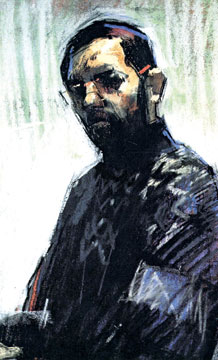How to paint a self-portrait
by Tissa Hewavitarane
Creating a self portrait begins when you look at the history of
self-portraiture and the work of some of the world's most famous
artists. Examples of work by the masters and by contemporary artists are
analysed in terms of techniques, approach and style in a practical and
highly visual manner, illustrated with step-by-step drawings and
paintings.
A careful study defines and illustrates the important factors that
determine the quality of the final result. Understanding and mastering
facial anatomy, handling composition and mood, setting yourself up,
understanding and manipulating light, understanding colour and creating
colour effects are the most important factors that you have to bear in
mind to turnout a good self portrait.
 |
|
A self-portrait done
with pastel |
Artists always reflect themselves in their painting the mood and
colour schemes of their works. Self portraits have been of great
interest to viewers and painters alike. For the spectators, they can
provide a marvellous insight into the character of artists and also into
their art itself, as the work of the old masters, such as Rembrandt,
reveals.
For artists the attractions of the self-portrait include the fact
that it enables them to paint fro life without hiring a model or being
limited by time other than their own.
Origin
Self portraiture is also the best way of learning how to depict the
human face, and in a range of media and styles. There are examples of
work by the old masters and the new accompanied by many methods and
approaches. They have commented on their art expressing the joys and
pains of producing self-portraits and describing how they painted each
piece linking their written thoughts on the work done by them.
Self-portraiture has existed since the ancient Egyptians when a few
painters in the middle of the second millennium B.C. were sculpting
narrative reliefs on tomb walls and adding their images to the carvings,
some of which were later painted. These artists observed themselves in
reflective polished stone, such as mirrors made from burnished metal.
Much later, Roman painters were painting portraits on to wood panels,
canvas and walls. During the European Dark Ages the light of culture was
shining bright on the east.
In China Wan Hsi-Chin, a calligrapher, is documented as having
painted his portrait with the aid of a mirror. But secular paintings
were frequently destroyed by succeeding dynasties and unfortunately the
self-portrait no longer exists. However, later many of them painted in
water-colour and ink on silk that lasted for long periods.
Among them there is a striking perceptive image by Kuan Hsiu that
displays remarkable sophistication and very elegant brushwork. The
earliest traceable two-dimensional self-portraits in Europe are in many
manuscripts.
Patrons
The monks who produced them occasionally depicted themselves in the
elaborate capitals they painted and showed themselves presenting their
work on their patrons. Later painters soon found another means of
introducing themselves into their work. In their images of St. Luke
painting Virgin Mary artists frequently depicted themselves as St. Luke,
their patron saint. One of the first painters known to do this was the
Netherlandish artist Rogier Van der Weyden (1399-1400-64). Other artists
were incorporating their images into paintings of a more secular nature.
The first artist to leave a series of studies of the self was Albrecht
Durer (1471-1484). This was followed by an image in 1493, advertising
himself as a handsome and suitable husband. Durer even painted himself
as Christ in his self-portrait a 'Saviour of the World' (1500-1506)
possibly to make the statement that as an artist he was different from
other men, and that the source of his talents were divine. In the 16th
century mirrors were first made from glass backed with mercury. These
gave a better reflection than the metal mirrors that had been used until
then.
It was not until Rembrandt that self-portraiture really became an art
from in its own right. His self-portraits provided as with the most
complete usual record of his life-time to an confident young man.
Rembrandt relied on an elaborate studio arrangement with double mirror
to paint some of his self-portraits. After Rembrandt almost every
successful artist painted a self-portrait.
In Spain, Velazquez ( 1599-1660). In France Nicolas Poussin
(1593-1665) produced two self-portraits considered as a classic. One of
the few women artists of the time, Marrie-Antoinette, Elizabeth Van
Lebrun (1755-1842) was also producing self-portraits.
Influential
But the modesty of her appearance in them was also greatly
influential on women's fashion of the time. In England, there were no
great English born portrait painters until the 1740s. George Romney
(1734-1802) and Sir Joshua Reynolds (1721-1792) the great 18th century
English painters and portraitists were less formal and more relaxed in
their work. Self-portraiture was better represented among post
impressionists such as Paul Cezanne and particularly Vincent Van Gogh.
Among the Expressionists self-portraiture was an ideal medium for their
painting philosophy. The nature of artists today comes through their
work much more strongly than before.
|

